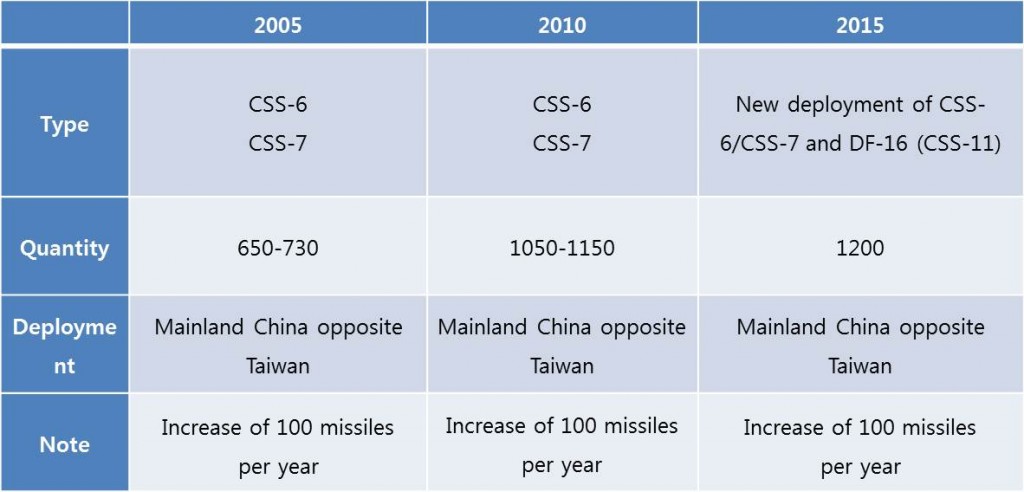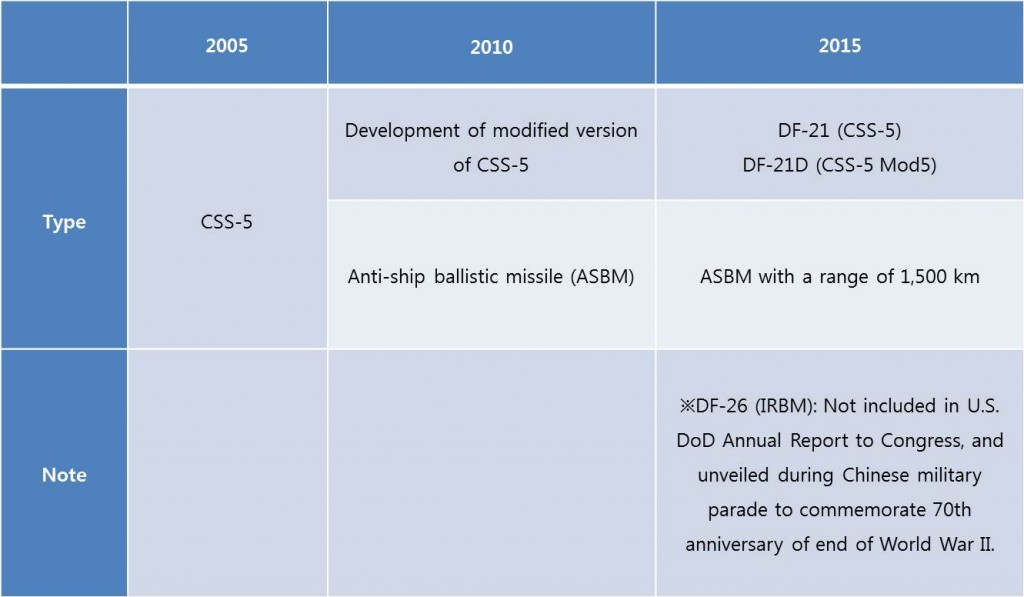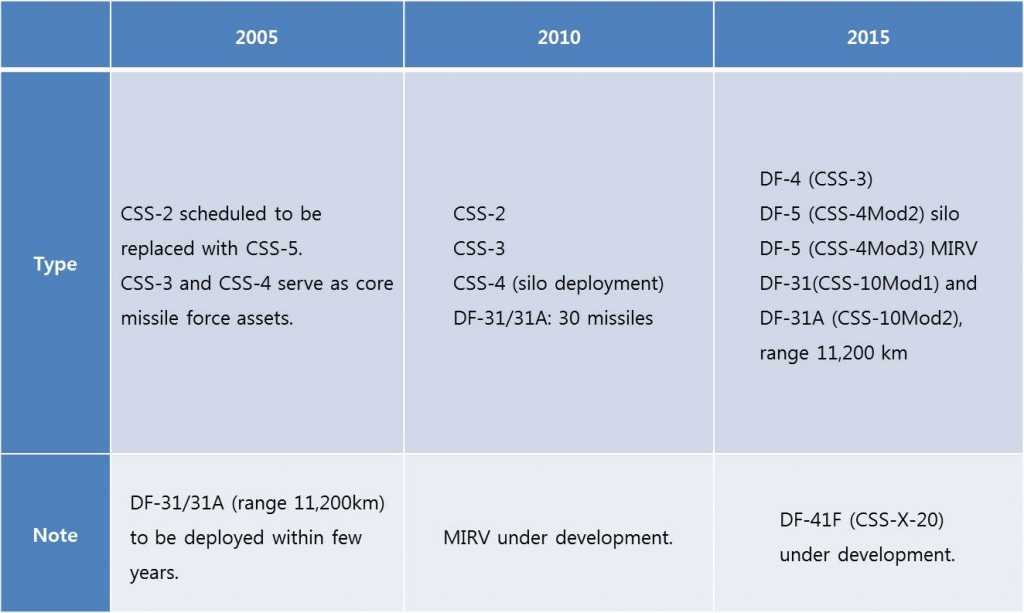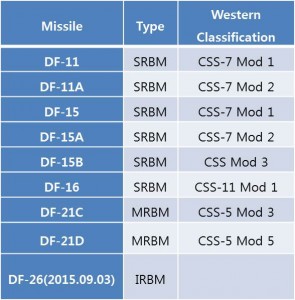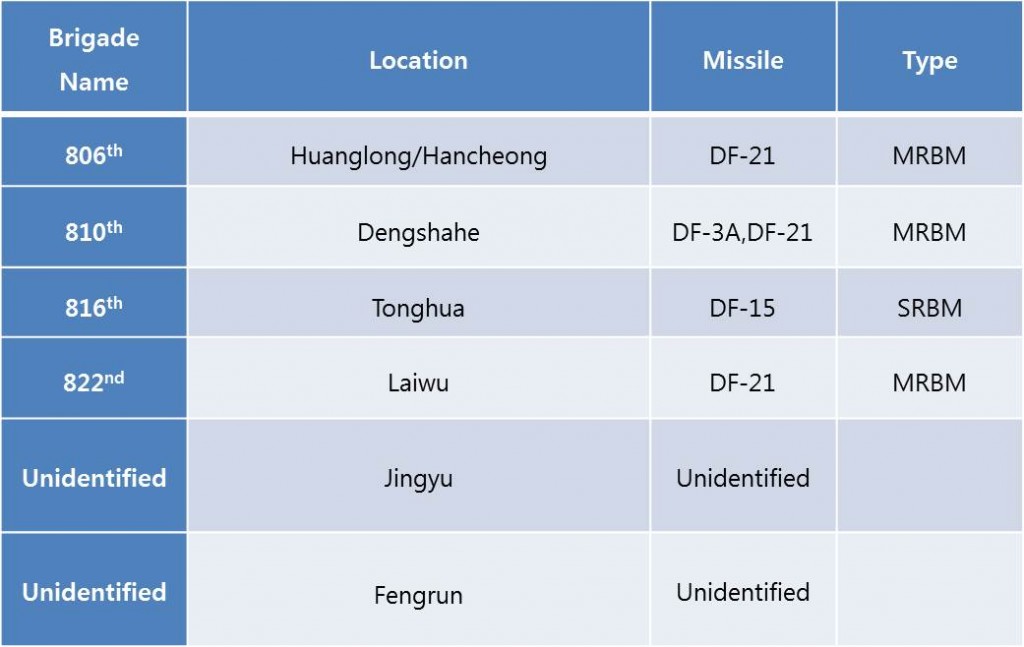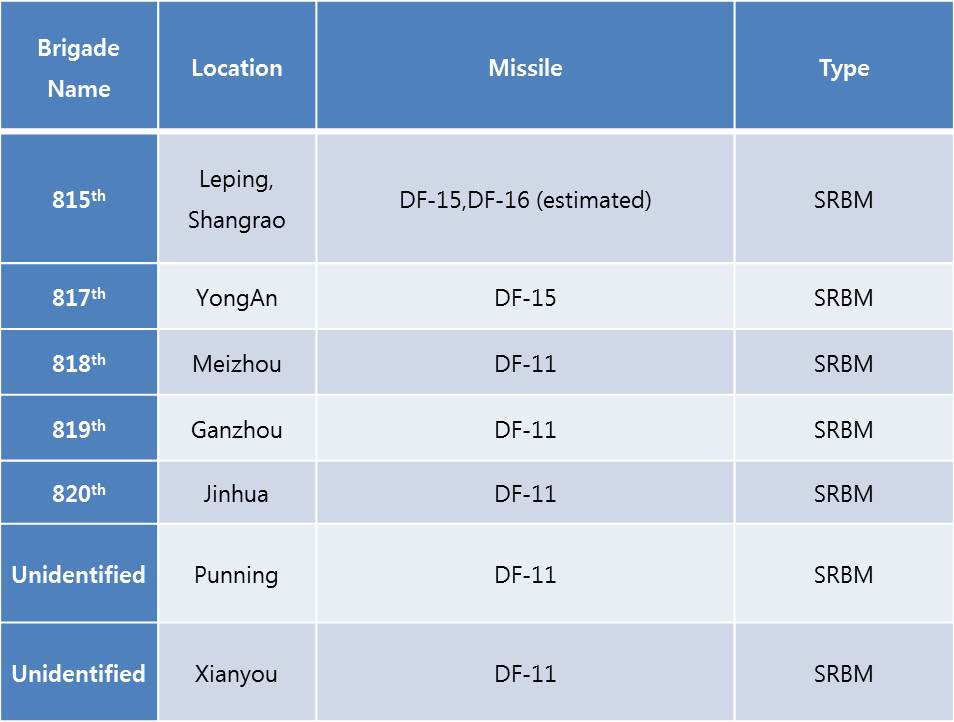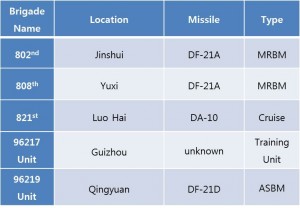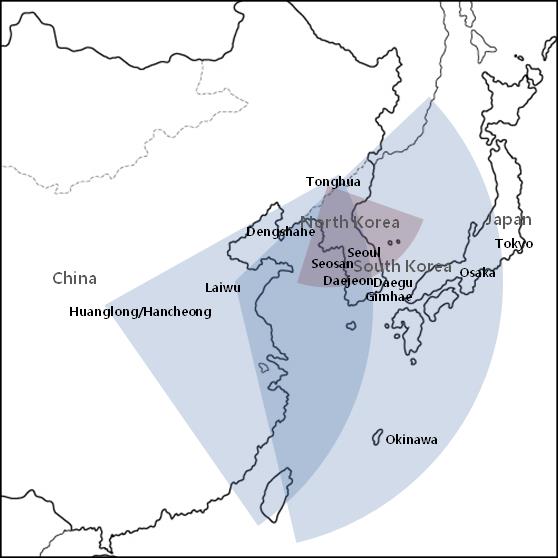Implications of China’s Ballistic Missiles
for Korean National Security 1
By Chief Editor Ahn Sung Kyoo, Director Choi Kang
and Research Associate Kweon Eun Yul
1. Introduction
China’s ICBMs per se do not pose a direct threat to South Korea. However, China’s SRBMs and IRBMs do pose a strategic threat for their potential use in support of North Korea should a conflict erupt on the Korean peninsula. The worst case scenario for South Korea is that these short- and intermediate-range missiles may be used to attack military targets based in South Korea.2 These missiles may also be used to interrupt or deny U.S. naval and aerial reinforcements to the peninsula, in effect neutralizing U.S. extended deterrence.
A study by the Center for Strategic and International Studies (CSIS), “U.S. Force Posture Strategy in the Asia Pacific Region: An Independent Assessment,” determined that China’s ballistic missiles are posing an increased risk to U.S. bases, especially in Japan and Korea.3 If Chinese missiles are seen as a serious challenge to the security of Korea, the pressure to deploy the Terminal High Altitude Area Defense (THAAD) system will gain more ground in Korean domestic circles.
The essential problem is the strategic implications of China’s diverse and expanding missile capabilities on the deployment and defense of South Korean forces. The range of Chinese missiles, including those recently unveiled,4 span thousands of kilometers from north to south along the coast from the border area between North Korea and China. The main function of China’s missile deployment is ostensibly defense and deterrence against U.S. attack, but the ramifications may differ when it comes to the Korean Peninsula, precisely because missiles in northeastern China can be redirected in support of North Korea in the case of a full scale conflict on the peninsula.
In the event that a large-scale military conflict takes place on the Korean Peninsula between North and South Korea, China has the option to utilize its nearby missiles, should it opt to provide military support to North Korea as it did during the Korean War over 60 years ago.5 With both short and long range capabilities, these tactical missiles could destroy both South Korean and U.S. air force bases, while deterring American aircraft carriers from reinforcing South Korean forces. In this scenario, these missiles may even hinder Korean reunification.6
Chinese missiles may hold the dual strategic functions of “offensive self-defense” and “the possibility to support North Korea in emergency situations.” “Offensive defense” is a concept targeting the United States. China will defend itself by launching a counter-offensive against the U.S. mainland with nuclear weapons in the event of a nuclear attack initiated by the U.S. The latter concept is to project Anti-Access/Area Denial (A2/AD), a self-defense strategy aimed at deterring U.S. conventional military forces that may try to intervene in a conflict involving China.
Nuclear missiles with second-strike capability are the DF-5B and the DF-31A. The DF-31A has a reported range of 11,200 km, with multiple independently targetable reentry vehicle (MIRV) capabilities with 3~5 warheads. The U.S. Department of Defense revealed the existence of the DF-31A in the “Annual Report to Congress: Military and Security Developments Involving the People’s Republic of China 2015.” However, at the September 2015 parade, China had only showcased the missile’s cylindrical launch platform. As the operational deployment of the DF-31 reportedly began in 2009,7 the DF-31A is likely to have been outfitted with improved functions.
As for the DF-41, the U.S. Department of Defense’s 2015 Annual Report to Congress revealed, “China is also developing a new road-mobile ICBM – the CSS-X-20 (DF-41) – possibly capable of carrying MIRVs.”8 China’s decision not to reveal this missile during its military parade indicates that the DF-41 has not become fully operational or that the decision was a political one to avoid provoking the U.S.
China boldly showcased the DF-21D and the DF-26, with ranges between 1,500 km and 4,000 km. If the DF-21D had been considered hitherto as a key military asset to deter the U.S. from the first island chain, the DF-26 further extends the coverage to over 3,000 km. With its recent military parade, China essentially hid its sword (ICBMs) while brandishing its shield (A2/AD).
2. China’s Nuclear and Conventional Missile Capabilities
1) Reinforcement of the Second Artillery Corps’ Missile Capabilities
Over the past 20 years, China has steadily reinforced its nuclear and conventional missile forces with a central focus on the Second Artillery Corps.9 In particular, China has focused on developing ballistic missile capabilities to counter America’s dominance in conventional power.10 The U.S. Department of Defense’s 2015 Annual Report to Congress also noted that China is developing and testing several new classes and variants of offensive missiles, forming additional missile units, and upgrading older missile systems.11 Consequently, China fields what it calls a “lean and effective” nuclear arsenal that is believed to be significantly smaller than the arsenals of the U.S. and Russia.12 China’s missile capabilities have been enhanced across all categories of short-range ballistic missiles (SRBMs), medium range ballistic missiles (MRBMs), intermediate-range ballistic missiles (IRBMs), and intercontinental ballistic missiles (ICBMs).13 Table 1 provides an analysis of changes in China’s missile forces over the past decade based on the “2015 Annual Report to Congress on China’s Military and Security Developments.”
Table 1. Changes in China’s Missile Forces
With respect to ICBMs, China had field-deployed around 50 to 60 missiles by the end of 2014, an increase of 20 missiles from 2005. The older DF-5 missiles were modified to carry multiple warheads for greater flexibility and deployed in underground silos in order to ensure first-strike nuclear survivability. China also added the DF-31 (CSS-10) and the new DF-31A to its arsenal. With a range in excess of 11,200 km, the DF-31A has the capacity to strike the U.S. West Coast.14
The core Chinese MRBM is the DF-21 (CSS-5), with a range of 1,700 km. The DF-21A, the DF-21C, and the DF-21D were developed as variants of the DF21. The DF-21D (CSS-5 Mod 5) is an anti-ship ballistic missile (ASBM), with a precision-guidance system, mated to a conventional tactical warhead, and serves as the foundation of China’s A2/AD strategy. China has fielded DF-21D specifically designed to hold adversary aircraft carriers at risk once they approach within 900 nm (approximately 1,600 km) of the Chinese southeastern coastline.15 The land-attack DF-21C (CSS-5 Mod 4) with a range of 1,800 km is another new variant that can target Okinawa and mainland Japan.16 The recently revealed DF-21D is known to have maneuvering ability.17 Demonstrating a greatly increased range, China is reportedly developing an IRBM (the DF-26) capable of putting U.S. forces in Guam at risk.18 This missile has a range exceeding 3,500 km,19 according to some media reports.20
In addition, the number of Chinese SRBMs steadily increased from 650-730 in 2005 to 1,050-1,150 in 2010 and then to 1,200 missiles in 2015. That is nearly a two-fold increase and reflects China’s strategy to add 100 SRBMs to its missile force each year since 2005. Key missile variants included the DF-15 (CSS-6) with a range of 600 km, and the DF-11 (CSS-7) with a range of 300 km. The DF-16 (CSS-11) was also newly deployed, with a range of 800-1,000 km.21 Figure 1 demonstrates this situation.
Figure 1. A2/AD Simultaneous Action
The U.S. Department of Defense’s 2015 Annual Report to Congress asserted that “as recently as ten years ago, several hundred short range ballistic missiles could cover targets in Taiwan, but China had only a rudimentary capability to strike many other locations within or beyond the first island chain, such as U.S. bases in Okinawa or Guam. Today, however, China is fielding an array of conventionally armed ballistic missiles.”22 By November 2013, the Second Artillery possessed more than 1,000 short-range ballistic missiles (SRBMs).23 The number of SRBMs had increased by 200 within a single year. However, the 2015 Annual Report to Congress failed to mention the DF-15, which was unveiled during China’s military parade. The DF-15 is classified as a short-range missile with a maximum range of 600 km. There is no explanation as to why the DF-15 was not included in the report. Since Dong Feng missiles are mostly deployed on mobile launchers (see Table 2), they would be difficult to destroy in a preemptive attack. In essence, enhanced mobility ensures survivability, and that in turn leads to greater counter-strike capability.
Table 2. DF Variants Deployed on Mobile Launchers
2) Concentrated Missile Deployment in Coastal and Border Regions
In essence, China’s A2/AD strategy aims to deny the U.S. armed forces access to surrounding areas (including the Western Pacific Ocean), by land, sea, or air. Beyond deterring threats against China, the strategy is also designed to restrict or hinder U.S. efforts in order to prevent the United States from fulfilling security and defense obligations to its allies in the region. As former U.S. Chief of Naval Operations Admiral Jonathan Greenert said, “A goal of an A2/AD strategy is to make others believe it can close off international airspace or waterways and that U.S. military forces will not be able (or willing to pay the cost) to reopen those areas or come to the aid of our allies and partners.”24 To this end, China has focused on reinforcing its conventional and nuclear ballistic missile capabilities. China’s A2/AD investments cover a plethora of conventional capabilities: anti-satellite investments, offensive cyber capabilities, conventional ballistic and cruise missiles with precision seekers designed to attack both fixed land installations and surface ships (particularly aircraft carriers), air to air capabilities including 5th generation fighters, long range advanced technology missiles, and electronic warfare systems.25 China’s foremost concern is to prevent enemy ships, in particular U.S. aircraft carriers, from dominating the area of the Western Pacific within the range of 1,500 km from its coast.26 The presence of maximum deployment of missiles in its coastal regions reflect such a strategy.
Although it is difficult to provide a complete assessment of China’s nuclear and conventional ballistic missile capabilities due to the lack of publicly disclosed information, it is possible to explore the country’s coastal warfare capabilities through various available documents. This paper utilizes data from five main sources: “Taiwan Defense Strategy in an Age of Precision Strike,”27 “PLA Second Artillery Corps,”28 The Chinese Army Today (2012),29 Project 2049 Institute blog titled “Asia Eye,”30 and “Chinese Second Artillery”31(中国二炮) released on China’s social media platform Baidu.
These sources provide analytical data including the names of China’s six corps-level missile bases and the deployed missiles. Although information is conflicting at times, one can reasonably deduce that there are six missile bases under the Second Artillery Corps: 51st, 52nd, 53rd, 54th, 55th, and 56th Bases. The 51st Base covers the northeastern regions, while the 52nd Base and the 53rd Base covers the central and southeastern regions.
A graphic summary of China’s missile forces is presented in Figure 2.
According to “PLA Second Artillery Corps,” there are six brigades stationed at the 51st Base. The brigades whose names have been identified include 806th, 810th, 816th, and 822nd Missile Brigades, while the remaining two remain unknown.
Figure 2. Location of Missile Bases and Types of Missiles
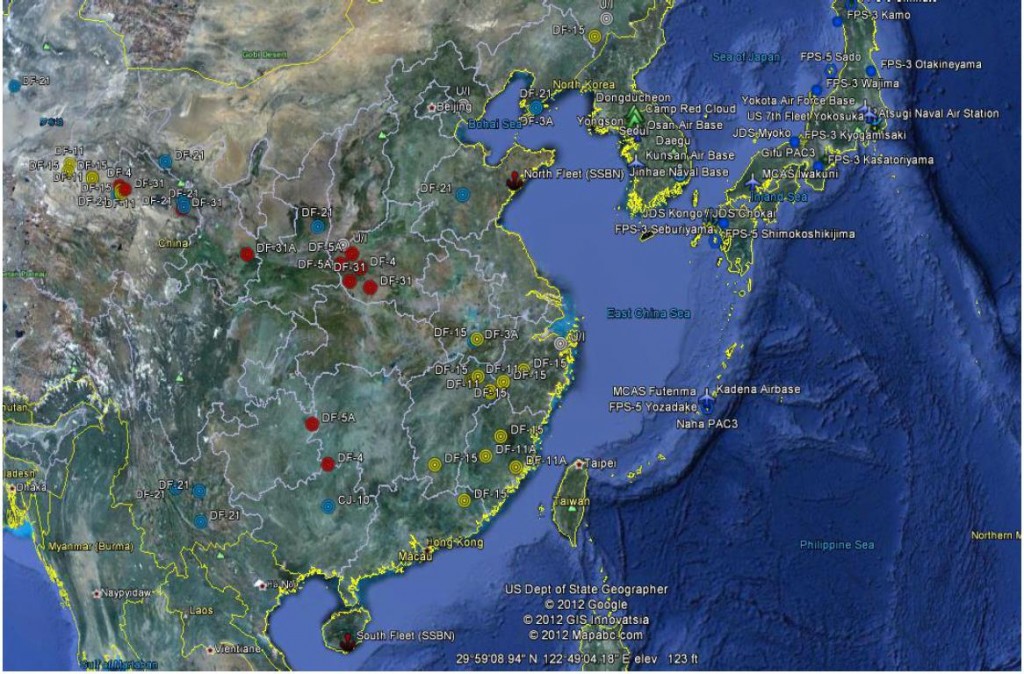
The colors red, blue, and yellow respectively indicate ICBM bases, MRBM bases, and SRBM bases.
Source: Sean O’Connor, “PLA Second Artillery Corps,” Air Power Australia, November 24, 2012,
http://www.ausairpower.net/APA-PLA-Second-Artillery-Corps.html.
Based in Huanglong (or Hancheong), the 806th Missile Brigade is equipped with the 1,700 km-range DF-21. The 810th Missile Brigade is located in Dengshahe on the Liaodong Peninsula. The brigade deploys the DF-3A with a range of 2,650 km and the DF-21 with a range of 1,700 km, both of which are armed with nuclear warheads. The 816th Missile Brigade located in Tonghua is equipped with the DF-15 short-range missile with a range of 600-900 km. The 822nd Missile Brigade located in Laiwu, Santung Province, is equipped with the DF-21 (see Table 3). The remaining bases have not been identified.
Table 3. Missile Deployments at 51st Base
The U.S.-China Economic and Security Review Commission (UCESRC)’s 2014 Report to Congress revealed that the DF-21D anti-ship ballistic missile is deployed at the brigade in Laiwu.32
The 52nd base, which is responsible for covering Taiwan, oversees seven brigades.33 As seen in Table 4, the 815th Missile Brigade, which encompasses both Leping and Shangrao, is armed with the DF-15. It is also presumed that the DF-16 is also armed. The 817th Missile Brigade (located in YongAn) is equipped with the DF-15, while the 818th Missile Brigade (located in Meizhou), the 819th Missile Brigade (located in Ganzhou), and the 820th Missile Brigade (located in Jinhua) are equipped with the DF-11. In addition, unidentified bases are located in Xianyou (DF-11) and Punning (DF-11).
Table 4. Missile Deployments at 52nd Base
The 53rd base, which is responsible for covering the South China Sea, consists of five brigades.34 The names of the bases and corresponding missile deployments are shown in Table 5. Notably, the DF-21D has been deployed at the base since 2011. In 2014, the UCESRC confirmed the deployment of the said ASBM.35
Table 5. Missile Deployments at 53rd Base
According to the five sources noted above, the 51st, 52nd, 53rd bases constitute a densely deployed missile strike system along the Chinese coast from north to south. The 52nd base, which covers Taiwan, deploys SRBMs, the 53rd base, covering the South China Sea, is equipped with MRBMs and IRBMs, and the 51st base, covering the northeastern regions, is equipped with IRBMs. The map in Figure 3 below illustrates China’s missile deployments and ranges.
Figure 3. China’s Missile Deployments and Ranges
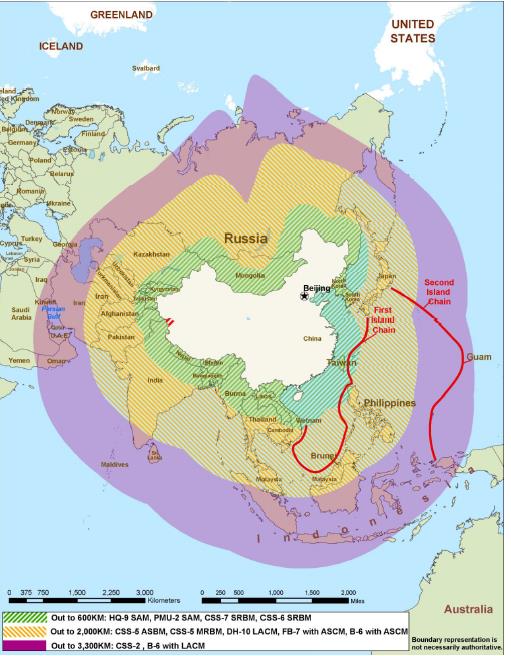
The colors – green, yellow, and purple – indicate corresponding ranges for SRBMs, MRBMs, and IRBMs.
Source: Dennis M. Gormley, Andrew S. Erickson, and Jingdong Yuan, A Low-Visibility Force Multiplier Assessing China’s Cruise Missile Ambitions, (Washington, DC: National Defense University Press, 2014).
3. Chinese Nuclear Doctrine
China asserts that its build-up of military strength (including missiles) is for defensive – not offensive – purposes. During a state visit to the U.S., Chinese President Xi Jinping said: “China has always pursued a defense policy that is defensive in nature and a military strategy featuring active defense,” and that “China has long pledged never to practice expansionism and seek hegemony.”36 Furthermore, he announced that “the size of China’s military will be cut by 300,000”37 during China’s September 3 military parade. But his words belie the reality of China’s increased defense spending.
The U.S. is rightfully suspicious of China’s national defense reinforcement. The U.S. Department of Defense 2015 Annual Report to Congress noted that the recent trend in China is to bolster its military forces across all branches in the name of reform. The report assesses that China is furthering its warfare capacity by reinforcing the air power of the army and navy, cyber espionage capabilities, Special Forces, and the Second Artillery Corps. Subdividing divisions into brigades is one aspect of boosting combat capabilities. At the same time, China downsized up to two regional corps and non-combat forces. These measures were assessed as attempts to increase flexibility in the military, and provide the early stage of developing an expeditionary force. There remains little doubt that China is now reinforcing its A2/AD capabilities, expanding its range of power projection, and operations in emerging domains such as cyberspace, space, and electro-magnetic spectrum.38 The report predicted that China’s strategic policy direction would be unveiled during 2015 and fully implemented by 2020. Military experts projected that China’s defense budget would almost double from $134 billion (approximately 159 trillion won) in 2010 to $260 billion by 2020.39 Such an aggressive augmentation is inconsistent with a defensive-oriented strategy.
The expansion of military capacity enables China to conduct long-distance operations, as its area of defense extends from coastal areas to the open sea. China is developing its long-distance operational capacity to protect trade routes including oil shipping routes from the Middle East, put pressure on territorial disputes such as the Spratly Islands, gain the upper-hand in a potential conflict involving Taiwan or the Korean Peninsula, and responding to separatist movements in Central Asia. Strengthening the Second Artillery Corps, which is in charge of China’s ballistic missiles and nuclear weapons, is consistent with the concept of “active defense.”
With regards to nuclear-tipped ICBMs, China’s nuclear doctrine is to survive an initial nuclear attack and respond with sufficient retaliatory strength to inflict extreme damage on the enemy. Under this strategic aim, the development of nuclear weapons focuses on high survivability and strong second-strike capability. To this end, China concentrates on next-generation mobile missiles, multiple-warhead missiles, and missiles that can penetrate an enemy’s defensive systems, as well as the enhancement of land platforms, maneuverable reentry vehicles (MaRV), MIRVs, decoys, chaff, jamming, and thermal shielding. In 2014, China reportedly tested a hypersonic glide vehicle capable of carrying nuclear warheads, and the press reported that China frequently conducts training to increase the survivability of the Second Artillery Corps.
In principle, China remains opposed to the idea of a preemptive nuclear attack. China asserts that it would use nuclear weapons only in response to a first strike against China, and would not threaten any non-nuclear-weapon states with its nuclear arsenal. But there is room for ambiguity. Some argue that if the survival of China’s nuclear force or of the regime itself is threatened, China might initiate the use of nuclear weapons.
The main aim of the investment on conventional ballistic missiles is to enhance China’s A2/AD capability.40 China postulates the possibility of military conflicts with neighboring countries such as Taiwan, and aims to block the access of U.S. military forces that may come to the defense of Taiwan. Using its missiles, China strives to prevent U.S. access into the air, maritime, space, electro-magnetic, and cyberspace domains of the Taiwan Straits.
China’s conventional missile capability has already undergone rapid development. Ten years ago, China could at most deploy several hundred short-range missiles that targeted Taiwan. It had a limited ability to attack locations beyond the first island chain, which connected core deployment locations of U.S. forces in the Western Pacific, such as Okinawa and Guam. Today, however, some 1,200 conventional missiles have been fielded. All U.S. bases in Guam and Japan including Okinawa are within the range of China’s MRBMs.
The U.S. government is now placing greater focus on China’s missile forces. Recent reports indicate that the U.S. plans to deploy around 15 percent of its Marine Corps to the Pacific.41 Although the proclaimed purpose of reinforcing U.S. military presence in the region is to deter provocation from North Korea, the United States also aims to be able to respond to possible conflicts with China in the South China Sea.
4. Implications of Chinese Missiles on South Korea’s Security
Chinese ICBM capabilities do not pose a direct threat to South Korea. The problem lies in the short- and mid- range missiles that possess the dual strategic functions of “protecting China” and “the possibility of supporting North Korea in an emergency.” The missiles could pose a threat, as they have the ability to strike the South Korean Air Force and US Air Force bases on the peninsula in the event of a military conflict. These bases would play a critical role in any wartime operation and their capability to augment US forces in Korea would be severally undermined.
The Center for Strategic and International Studies (CSIS) states in their report, “U.S. Force Posture Strategy in the Asia Pacific Region: An Independent Assessment,”42 that American bases in South Korea and Japan are at great risk from Chinese ballistic missile attacks. If Chinese missiles continue to threaten South Korea, securing the deployment of the THAAD missile defense system will have even greater strategic value.
1) Possibility of Attack on Korean Air Force Bases in Conflict
China’s main medium-range ballistic missiles, the DF-21 and its variants, may pose a direct threat to South Korea. In “Chinese Mobile Ballistic Missiles: Implications for U.S. Counterforce Operations,” Matthew Hallex notes that the DF-21 also threatens U.S. bases in Taiwan, Japan, Okinawa and Korea.43 Furthermore, the DF-21C (a variant armed with conventional warheads) and the DF-21D can hit all targets in Korea and Japan..44
The presence of SRBMs also is a potentially significant threat. One of the greatest concerns stems from the weapons held by the 816th Missile Brigade at Tonghua – the DF-15 with a range of 600-900 km.45 Within its given range, there is no other potential target except South Korea. China’s SRBM deployment should be seen as military assets positioned to directly attack South Korea or support North Korea in an emergency.
Under the Second Artillery Corps, each brigade deployed with SRBMs consists of six launch battalions, a technical support battalion, a communications battalion, an electronic countermeasures (ECM) battalion, and a rail transfer team. Each battalion carries six to 12 launchers, and each launcher is assigned to seven to eight missiles.46 Taking the number of launchers and missiles per launcher into calculation, the 51st Base is estimated to have deployed around 200 missiles at minimum and 500 missiles at maximum.
The following two studies illustrate the potential magnitude of the missile threat. A 2009 RAND paper, “A Question of Balance: Political Context and Military Aspects of the China-Taiwan Dispute,” notes that a concentrated preemptive attack by SRBMs with a 40 m circular error probability (CEP) may destroy 90 percent of airfield runways in Taiwan. The Project 2049 Institute also examined the potential devastation of Chinese missiles to destroy Taiwan’s runways.47
The scenario can be applied to the Korean Peninsula. The 822nd Missile Brigade at Laiwu under the 51st Base is believed to be equipped with the DF-21C with a range of around 1,700 km,48 and the missile is highly accurate with a CEP of 30-40 m.49 If the DF-21 variant is adjusted to a range of 1,500 km and launched against the K-2 Air Force base in Daegu for example, it will reach the apogee of 391 km and strike the base in 677 seconds (11 minutes 2 seconds).50 If Chinese missile strikes destroy airfields in Korea during a conflict, this will lead to a drastic decline in the operational capabilities of some 1000 U.S. aircrafts.
Figure 4 is an offensive range map showing the locations of brigades under the 51st Base and the ranges of deployed missiles. All military bases in South Korea, including those of U.S. forces, are within the range of the DF-21 deployed in Huanglong (Hancheong), the 51st Base’s presumed headquarters. If China is able to strike Korea from the 51st Base, which is geographically the furthest from Korea, the missiles deployed closer than that pose considerable problems for South Korean defense planners.
Figure 4. Interception Range of Missiles at 51st Base against Korean Peninsula (DF-15 and DF-21)
2) Prevention of U.S. Intervention and Incapacitation of Extended Deterrence
In the event of war in Taiwan or the Western Pacific, Chinese land-attack ballistic and cruise missiles can threaten critical U.S. air and naval facilities on the islands of Okinawa and Guam.51 The DF-21D ‘carrier-killer’ missile may deter the United States’ carrier strike groups to enter the region while establishing an effective operational distance.
Similarities exist on the Korean Peninsula. Fielded with the 822nd Missile Brigade at Laiwu under the 51st Base, the DF-21D may target U.S. aircraft carriers entering the seas to the east and west of Korea. This may constitute a serious threat with the potential to interrupt U.S. military reinforcements from Okinawa, Guam, or the U.S. mainland, and to disturb or possibly prevent active intervention by the U.S. in any conflict on the Korean peninsula.52
As former U.S. Chief of Naval Operations Jonathan Greenert commented: “In peacetime, this gives the country with the A2/AD weapons leverage over their neighbors and reduces U.S. influence. In wartime, A2/AD capabilities can make U.S. power projection more difficult.”53
The reason China’s conventional ballistic missiles pose a greater threat than nuclear missiles is that the Chinese are less circumscribed when it comes to conventional missile strikes. China has historically subscribed to a “second strike only” nuclear warfare doctrine. China vowed that it would never use nuclear weapons first against any nuclear-weapon state. China also stated that it would never use or threaten to use nuclear weapons against any non-nuclear-weapon state or nuclear-weapon-free zone.54 However, China has no equivalent stance in regards to conventional missiles.
China is obviously unlikely to preemptively launch missiles against Korea without a highly compelling reason. Although a hypothetical situation where China strikes South Korea or the U.S. first to protect North Korea can be imagined, this is a very low possibility. However, the problem is that missiles may emerge as an option for China in times of crisis. Evan Branden pointed out that “China might be tempted to launch a missile attack when tensions are high,” which is why “this is an increasingly important issue, not only for the U.S., but also for its allies and partners throughout East Asia.”55 As China’s Defense White Paper 2015 emphasizes, China will absolutely “do what it can do (大有作爲)” to protect national interests in each field at home and abroad, which in turn enhances the importance of the offensive capabilities of China’s missiles.56 If military tensions between the two Koreas become more volatile or if North Korea faces imminent attack or the risk of collapse, China might use its missiles to support the North Korean regime. If South Korea and the U.S. face the need for a strong response against provocation from North Korea, China might try to end the situation by using its missiles as leverage. In accordance with the party leadership’s decision, China may use the possible launching of missiles as an instrument of pressure in various circumstances.
Having mainly focused on North Korean missiles, South Korea has little practical counterstrategy against China’s missiles. The comparison of missile ranges between China and South Korea presents a clear gap in terms of missile capabilities. Currently under development, South Korea’s latest missile has a range of 500 km, and if launched from the central area of Korea, it can barely reach the Shantung region. Even if Korea strives to extend its range to 800 km, it cannot effectively attack key strategic targets in North Korea. Ultimately, its damage scope is limited because the warhead weight is restricted to 500kg.
5. Conclusion
Whether China’s ballistic missiles can be a threat to South Korea’s national security depends on the circumstances. Nevertheless, Korea is ill-equipped with proper countermeasures against this potential threat. It possesses no medium- or long-range missiles, while its recently tested short-range missile has a maximum range of 500 km.
Korea’s missile defense capacity is also inadequate. The South Korean military possesses only two early warning systems capable of missile defense: the Israeli Green Pine radar with a 500 km range, and the Aegis SPY radar. South Korea is currently working on a project to deploy 136 PAC-3 interceptor missiles by 2020. But the PAC-3s fielded by U.S. Forces in Korea will not be able to offset the ballistic threat from China. If and when Chinese missiles become a simultaneous threat with the North Korea threat, South Korea will likely find itself lacking any potent countermeasure.
In fact, establishing a missile defense system in anticipation against China will not be an easy task. The Kill Chain preemptive strike system or the Korean Air and Missile Defense System (KAMD) are no match for Chinese missiles. Further dependence on the U.S. is one option, but as evidenced by the public controversy against THAAD, deployment of the U.S. missile defense system in Korea is an extremely delicate issue.
For South Korea, the threat of North Korea is a substantial burden in itself, but Chinese missiles add to that burden. From the perspective that military readiness can only be measured by capabilities, irrespective of China’s intentions, Korea must commission in-depth studies on analyzing more powerful responses to Chinese missile capabilities.
The views expressed herein do not necessarily reflect the views of the Asan Institute for Policy Studies.
- 1.
This article was originally published in Korean on Nov 10, 2015.
- 2.
For example, targeting the air bases of South Korean and U.S. forces which play an extremely important role in case of inter-Korea military collision.
- 3.
CSIS, “U.S. Force Posture Strategy in the Asia Pacific Region: An Independent Assessment,” 2012, p.20.
- 4.
The recent military parade in Tiananmen Square on September 3, 2015 demonstrated China’s formidable missile arsenal and development. China unveiled around 100 missiles across 14 types, including anti-ship missiles and ballistic missiles. Those missiles included DF-5B and DF-31A intercontinental ballistic missiles (ICBMs), DF-15B and DF-21D intermediate range ballistic missiles (IRBMs), and DF-26 medium range ballistic missiles (MRBM). The DF-21D and the DF-26 were new additions to the arsenal.
- 5.
Under the condition that North Korea fully develops its nuclear arsenal, there are two possible scenarios where large-scale military conflict will be triggered. In the first case, North Korea will attack South Korea by conventional warfare once it has sufficient confidence as a nuclear power. In the second case, North Korea might attack when influenced by the spill-over effects of the Taiwan crisis between U.S. and China. Of course, both scenarios assume that Chinese military power grows enough to match or counter U.S. military power and thereby reduce the threat to North Korea.
- 6.
The missiles would block the rare chance to unify the Korean peninsula through military force, as China did 60 years ago when it intervened to support North Korea with its military, even though the North initiated the conflict.
- 7.
“DF-31/-31A (CSS-9),” Missile Threat, http://missilethreat.com/missiles/df-31-31a-css-9/?country=china#china.
- 8.
U.S. Department of Defense (DoD), “Annual Report to Congress 2014” (2014), p. 8.
- 9.
The Second Artillery Corps was renamed as the Strategic Army in 2016. As this article was published in the Korean before this name change took place, the text uses the former term. Yoo Ji-yong, “Trends in China’s Reinforcement of Nuclear and Missile Forces and the U.S.-China Rivalry,” Weekly Defense Review, Korea Institute for Defense Analyses, 2015.
- 10.
Ian Easton, “Taiwan Defense Strategy in an age of Precision Strike,” Project 2049 Institute, September 5, 2014.
- 11.
U.S. Department of Defense (DoD), “Taiwan Defense Strategy in an age of Precision Strike,” The U.S.-China Rival Republic of China 2013” (2013), “Annual Report to Congress: Military and Security Developments Involving the People’s Republic of China 2014” (2014), “Annual Report to Congress: Military and Security Developments Involving the People’s Republic of China 2015” (2015).
- 12.
CRS, “Ballistic Missile Defense in the Asia-Pacific Region: Cooperation and Opposition,” April 3, 2015, p.7.
- 13.
Effective range: SRBMs, within 1,000 km; MRBMs, 1,000-3,000 km; IRBMs, 3,000-5,000 km; and ICBMs, over 5,000 km. MRBMs target both land- and sea-based targets within the first island chain, including aircraft carriers, while IRBMs conduct near-precision strikes out to the second island chain. Table 1 is based on classification by the U.S. Department of Defense.
- 14.
The new road-mobile ICBM DF-41 (CSS-X-20) is also under development.
- 15.
U.S. DoD, ad-mobile ICBM DF-41 (CSS-X-20) i p.35.
- 16.
U.S. DoD, ad-mobile ICBM DF-41 (CSS-X-20) i p.39.
- 17.
There is an observation that DF-21D has guidance control in the terminal phase. Global Security, “WU-14 Dong Feng-21D (DF–21D) /CSS-5 Mod 5 Anti-Ship Ballistic Missile (ASBM),” http://www.globalsecurity.org/wmd/world/china/df-21d.htm
- 18.
It is presumed to be the IRBM with a range exceeding 3,000 km.
- 19.
Free Beacon, “China Fields New Intermediate-Range Nuclear Missile,” March 3, 2014, http://freebeacon.com/national-security/china-fields-new-intermediate-range-nuclear-missile.
- 20.
The U.S.-China Economic and Security Review Commission (UCESRC) concluded that China is also developing an IRBM with a range of 1,864-3,418 miles (3,355-6,152 km), which can attack U.S. bases in Guam, northern Australia, the Middle East, and the Indian Ocean, to be completed by around 2020. This assessment is possibly describing the DF-26.
- 21.
U.S. DoD, “Annual Report to Congress 2014” (2014).
- 22.
U.S. DoD, “Annual Report to Congress 2014” (2014), p.46. China currently has at least 1,200 conventionally armed ballistic missiles.
- 23.
U.S. DoD, U.S. DoD, “Annual Report to Congress 2014” (2014).
- 24.
U.S. DoD, The areas where A2/AD threats are most consequential include areas around the Straits of Hormuz and Gibraltar, Suez Canal, Panama Canal, or Malacca Strait. Speech of former U.S. Chief of Naval Operations Admiral Jonathan Greenert, ‘Projecting Power, Assuring Access,’ http://cno.navylive.dodlive.mil/2012/05/10/projecting-power-assuring-access/ (accessed on August 2015).
- 25.
Frank Kendall, “U.S. Under Secretary of Defense: Testimony before the House Armed Service Committee,” January 28, 2014.
- 26.
CRS, “Ballistic Missile Defense in the Asia-Pacific Region: Cooperation and Opposition,” April 3, 2015.
- 27.
Easton, “Taiwan Defense Strategy in an age of Precision Strike.”
- 28.
Sean O’Connor, “PLA Ballistic Missiles: Technical Report APA-TR-2010-0802,” Air Power Australia, August 2010, http://www.ausairpower.net/APA-PLA-Ballistic-Missiles.html.
- 29.
Dennis J. Blasko, The Chinese Army Today: Tradition and Transformation for the 21st Century, 2nd ed. (Routledge, 2012).
- 30.
Mark Stokes, “Expansion of China’s Ballistic Missile Infrastructure Opposite Taiwan,” Project 2049 Institute, April 18, 2011, http://blog.project2049.net/2011/04/expansion-of-chinas-ballistic-missile.html.
- 31.
‘中国二炮‘ is considered an important Chinese document as it contains numerous details that corroborate western expert analysis mentioned in this paper. “Chinese Second Artillery” [中国二炮], March 9, 2010, http://blog.sina.com.cn/s/blog_571641ee0100h9jf.html.
- 32.
UCESRC, “2014 Report to Congress” (Nov. 2011).
- 33.
Ian Easton, “Taiwan Defense Strategy in an Age of Precision Strike,” p.4.
- 34.
This document includes Puning, but according to the Project 2014 Institute’s document released in September 2014, the brigade was relocated to the 52nd Base. Mark Stokes, “Expansion of China’s Ballistic Missile Infrastructure Opposite Taiwan,” Project 2049 Institute, April 18, 2011, http://blog.project2049.net/2011/04/expansion-of-chinas-ballistic-missile.html.
- 35.
UCESRC, “2014 Report to Congress,” p.137.
- 36.
“Xi Jinping Emphasizes China’s Military Power Reinforcement is Defense-Oriented,” The Munhwa Daily, September 23, 2015.
- 37.
“China President Xi Gives Policy Speech in Seattle, Wants to Fight Cybercrime with the U.S.,” The Nelson Report, September 23, 2015.
- 38.
U.S. DoD, “Annual Report to Congress 2015” (2015), Chapter 3 ‘Force Modernization Goals and Trends,’ p/ 31-48.
- 39.
“China Cuts Troops but Increases Defense Spending,” The Dong-a Ilbo, September 7, 2015, http://news.donga.com/Main/3/all/20150907/73468253/1
- 40.
The term is used by the U.S., not by China.
- 41.
Chae Byeong-geon, “US Force Strengthen Real Time Action…Efficient to Put Pressure on China,” The JoongAng Daily, September 25, 2015, p.A6.
- 42.
CSIS(2012), “U.S. Force Posture Strategy in the Asia Pacific Region: An Independent Assessment”, p.20.
- 43.
Hallex, “Chinese Mobile Ballistic Missiles,” CSIS, p.38.
- 44.
Reports suggest that China’s missile base in Jilin near Mt. Baekdu performed DF-21 training in order to target U.S. bases in Japan. PLA’s DF-21D missiles already in service, says US report, Want ChinaTimes, September 15, 2014, http://www.wantchinatimes.com/news-subclass-cnt.aspx?id=20141015000124&cid=1101, “China deploys DF-21 nuclear missiles, capable of destroying US military bases in Japan,” The China Daily Mail, January 20, 2015, http://chinadailymail.com/2015/01/20/china-deploys-df-21-nuclear-missiles-capable-of-destroying-us-military-bases-in-japan.
- 45.
Kim Byeong-ki and Ahn Seong-gyu, “DF-21 Has a Range of 1,800 km and Can Reach U.S. Bases in Okinawa with a Circular Error Probable of 50 m, while 500 Missiles and 830 Warplanes Target the Korean Peninsula,” JoongAng Sunday, September 26-27, 2010, pp. 4-5.
- 46.
Ian Easton, “Taiwan Defense Strategy in an Age of Precision Strike,” Project 2049 Institute, September 2014.
- 47.
ibid.
- 48.
“Expansion of China’s Ballistic Missile Infrastructure Opposite Taiwan,” Asia Eye: The Official Blog of the Project 2049 Institute, April 18, 2011, http://blog.project2049.net/2011/04/expansion-of-chinas-ballistic-missile.html.
- 49.
“DF-31/-31A (CSS-9),”Missile Threat, http://missilethreat.com/missiles/df-31-31a-css-9/?country=china#china.
- 50.
Ian Easton, “Taiwan Defense Strategy in an Age of Precision Strike,” p.13.
- 51.
Major Christopher J. McCarthy, “Anti-Access/Area Denial: The Evolution of Modern Warfare,” U.S. Air Force, Naval War College, May 3, 2010, https://www.usnwc.edu/Lucent/OpenPdf.aspx?id=95. Publication date unspecified. However, footnotes indicate that it was written after 2011.
- 52.
Regarding the DF-26, there is no information on the base to which the newly revealed missiles are deployed. If the medium-range ballistic missiles with a maximum range of 3,000 km are deployed in southeastern China, they will be able to strike Guam, much like North Korea’s Musudan missiles. The U.S. military in Guam is also designed to support the Korean Peninsula when necessary.
- 53.
Speech of former U.S. Chief of Naval Operations Admiral Jonathan Greenert, “Projecting Power, Assuring Access,” September 27, 2012.
- 54.
U.S. DoD, “Annual Report to Congress 2015” (2015).
- 55.
Evan Braden, “Managing China’s Missile Threat: Future Options to Preserve Forward Defense,” Center for Strategic and Budgetary Assessments, April 1, 2015.
- 56.
Choi Hyeong-gyu, “Active Defense… China Revises National Defense Strategy in 66 Years,” JoongAng Ilbo, May 27, 2015, p. A16.

 Facebook
Facebook Twitter
Twitter